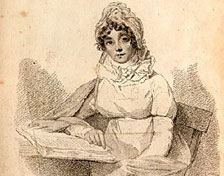This site has amassed a scholarly archive of poetry by 76 British and Irish women poets. The works cover the period from the onset of the French Revolution in 1789 to the year that Britain passed its Great Reform Act, extending adult male suffrage, in 1832.
These two events, and the debates surrounding them, framed the experiences of the writers represented on this site. Instructors interested in using literary texts as historical sources could employ material from this site in order to consider how writers reflected the fraught political climate of this period in their compositions.
The site makes available complete texts of British poetry that were not readily accessible. Many of the texts are not well known and are only beginning to be of interest to the scholarly community. Links to roughly 2,000-word biographies from the On-Line Literary Encyclopedia are included for six of the poets, but the only information about the majority of the texts’ authors comes from the texts themselves.
A few of the texts contain images of the authors, reproduced in frontispieces (as in Elizabeth Bentley’s Genuine Poetical Compositions, 1791), or illustrations that accompanied poems (such as Anne Bannerman’s The Dark Ladie). Additional contextual information is occasionally traceable through some of the publications’ front matter, such as the list of subscribers recorded in the opening pages of Genuine Poetical Compositions.
The site features a search function, permitting readers to analyze the database’s holdings by keyword. (On a trial basis, however, the results obtained through it seemed somewhat incomplete.) It is also possible to search the database through a link to the OAIster search engine from the University of Michigan, although this search does not produce comprehensive results in terms of subject and keyword searches.
Another shortcoming of the site is that it lacks a general introduction about what the Romantic Period signified—historically or poetically. This would assist instructors in designing exercises involving the texts available here. Teachers can find such an introduction in Dr. Karen Droisen’s brief discussion of the political context of English Romantic writers.
Viewers will also find some useful discussions of these points through the British Women Romantic Poets Links page. This page contains links to The Romantic Chronology (a site that situates this period’s writing in terms of its historical context); electronic journals, such as Romanticism on the Net; and Romantic Links, Electronic Texts, Home Pages, and Syllabi, an extremely helpful site offering primary sources, biographies, journals, and scholarship.
Literary scholars continue to debate the reasons for Romantic writers’ characteristic rejection of classicism and Enlightened rational thinking in favor of their characteristic celebration of subjective, sentimental, and individual experiences. Droisen’s recent thinking is that the political turmoil engendered by fears of political radicalism during and after the French Revolution caused stringent governmental censorship of writers and political groups, thus forcing authors, outwardly, to disclaim the political intent of their works.
Given this context, instructors could use the texts available at the site in a number of ways. Students could use secondary sources to study debates dividing England at the time of the French Revolution and then see how these poets expressed their views of these conflicts in explicit discussions—such as England and Spain; or Valour and Patriotism by Felicia Dorothea Browne Hemans.
Alternatively, teachers might encourage students to analyze how these poets indirectly expressed their political attitudes through representations of characters or values of earlier—less immediately fraught—eras, using, for example, such works as Ann Bannerman’s Tales of Superstition and Chivalry. Such an approach might also be adapted to the discussion of their representations of seemingly apolitical topics, such as the natural world.
In a different vein, the texts might also be used as a venue through which to understand women’s reactions to their own historical experiences. Students might read the biographical portraits of authors like Charlotte Turner Smith, and then try to detect how she expressed elements of her own lived experience—of marriage, labour, or class hierarchy, for instance—in such works as her Elegiac Sonnets, and Other Poems.



